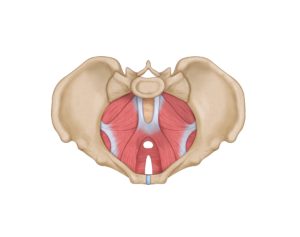The “pelvic floor” refers to the muscles and connective tissue that span the opening of the pelvis. We often think about the pelvic organs (the bladder, rectum, and uterus for people with female anatomy). However, most people are unfamiliar with the dynamic and functional pelvic floor muscles. While there are a few individually named muscles, the pelvic floor is generally grouped into two layers.

Deep layer: A bowl of muscles that sits inside the bones of the pelvis. It forms the bottom of the core and supports the pelvic organs. When it contracts, it shortens and lifts upwards towards your head.
WHAT DO THE PELVIC FLOOR MUSICS DO?
Bladder
- These muscles prevent urine leakage by closing sphincters and working against pressure changes. If you’re having urinary leaking, check out our pages on stress urinary incontinence and urge urinary incontinence!
- They relax muscles when you want to pee to allow the bladder to squeeze urine out
Bowel
- They prevent gas/stool leakage by closing sphincters and working against pressure changes. If you are experiencing leaking of gas or stool, check out our page on fecal incontinence!
- They relax and lengthen when you’re having a bowel movement
Sexual
- The pelvic floor muscles facilitate and maintain erection of the penis/clitoris. If you are experiencing erectile dysfunction of the penis, check out more information here.
- They provide friction at the vaginal opening for pleasure
- These muscles help increase sensations of orgasm for male and female anatomy through rhythmic contractions
Strength
- The pelvic floor muscles form the bottom of the core. Because of their location, they help create intra-abdominal pressure. This allows us to move and exert effort without falling over!
- Many people think that the core muscles are only worked during “core exercises.” However, the core (including the pelvic floor) is active all the time to some degree! It works hard with all kinds of exercise, including upper and lower body strength training, for example. Keeping your whole body healthy and strong is a great way to keep your pelvic floor muscles in good shape!


Nina's interest in Pelvic Health began during her graduate studies, when she realized how underserved this population was. She went on to complete a year-long residency program at Agile Physical Therapy to further her knowledge in helping women, men, and people of all gender identities regain confidence in their pelvic floor function. Nina understands how sensitive these issues are and hopes to help destigmatize bowel, bladder, and sexual dysfunction and empower people to seek the care they need to return to the activities they love.
